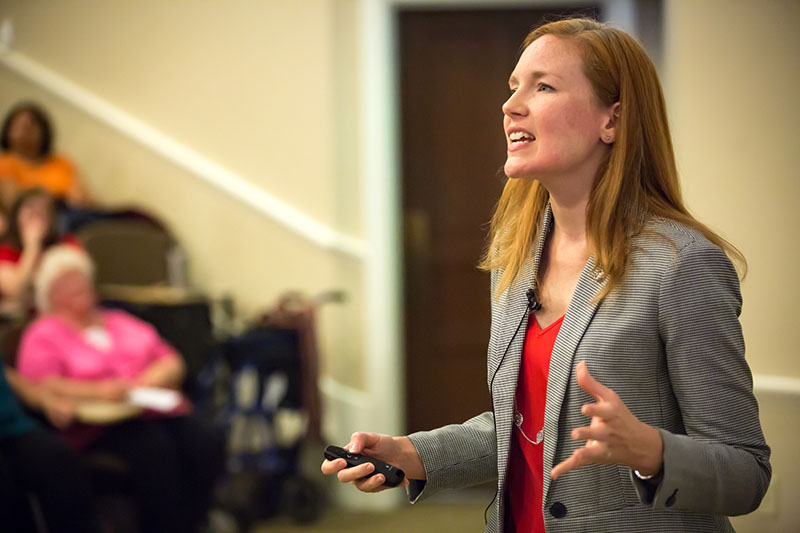
The Sky’s The Limit
As a girl, astrophysicist Amber Straughn fell in love with the night sky that twinkled above her family’s watermelon farm in tiny Bee Branch, Arkansas, sparking an interest in studying astronomy.
She came to the University of Arkansas to study physics with the Honors College, and the opportunities she experienced set her trajectory toward a career with NASA and the most advanced telescopes in the world.
“My decision to come to the University of Arkansas was one of the most important decisions I’ve ever made,” she said, noting that the U of A provided her with her first opportunity to stretch intellectually and find like-minded people who were also passionate about physics.

Star Power
Straughn experienced her “first brush with NASA” as an undergraduate at the U of A when she was part of a team that developed a reduced gravity flight experiment. The experiment resulted in a trip to Johnson Space Center and became the catalyst for her future work with the organization.
“Astronomy gets to the heart of our big questions – questions humans have been asking for millennia,” she said. “‘Where do we come from? How did we get here? Are we alone?’”
 Straughn was the first in her family to receive a college degree.
Straughn was the first in her family to receive a college degree.
Straughn went on to receive her master’s and doctoral degrees from Arizona State. She joined NASA full-time at the Goddard Space Flight Center in Greenbelt, Maryland in 2008 and is currently the associate director of the Astrophysics Science Division, as well as the deputy project scientist for James Webb Space Telescope Science Communications. The Webb Telescope, NASA’s biggest and most powerful telescope yet, launched into deep space on December 25, 2021, after 20-plus years of development and has only recently started sending images back to Earth.

Time Machines
Straughn’s research focuses on how stars and black holes form in distant galaxies and how those processes change over time. Prior to the launch of the Webb Telescope, she relied on data from the Hubble Telescope that NASA launched when she was in fifth grade. The Webb Telescope, equipped with a 22-foot-wide mirror – seven times bigger than that of the Hubble – and a sunshield that’s roughly the size of a tennis court, will help answer some of the questions that the Hubble can’t quite get to.
“Telescopes are like time machines – they allow us to look into the past,” she said. “The Webb Telescope will help us find the very first galaxies born after the Big Bang. We’re talking about looking back in time, over 13 and a half billion years into the past, to see those first galaxies. We’ll also be able to study the atmospheres of the nearest exoplanets – planets orbiting other stars – to help search for life in the universe.”
In addition to guiding the engineers working on the Webb Telescope, Straughn is charged with communicating progress on the project. She has addressed audiences of more than 2,000 people at events such as Comic Con and the World Science Festival and has appeared on the Discovery Channel, PBS NOVA, the Science Channel, National Geographic and Late Night with Jimmy Fallon, among others.

In July 2022, Straughn was part of the communications effort behind the Webb Telescope’s release of its first images.
“Seeing the images for the first time was an emotional experience for me,” she said. “The Carina image, especially – I felt joy, awe, overwhelmed – it’s just so beautiful. The universe is just so stunningly beautiful. These images also make me feel hopeful. They represent decades of work by thousands of people from all over the world all working together for a common goal of something that’s good. That gives me hope – that we, as human beings, can solve more of the hard problems that face us as a society.”

Reach for the Stars
Straughn believes that growing up in Arkansas is a plus for future scientists like herself, because there’s an abundance of natural beauty and vast nighttime skies. “Take every opportunity to explore your surroundings,” she says, while also noting that it’s not necessary to do so alone. “There’s this common stereotype of a scientist as a lone genius, and that’s a myth. Scientists work in teams, face challenges and obstacles, and often need help to solve problems.”
 Straughn’s love of all things air and space prompted her to become a pilot; she earned
her private pilot’s license in early 2013.
Straughn’s love of all things air and space prompted her to become a pilot; she earned
her private pilot’s license in early 2013.
“As a scientist, I think the most exciting prospect for me is this idea, really this guarantee, that we’ll discover things about the universe that completely surprise us,” she says. “We’ll find things that we had never dreamed of, and we’ll find answers to questions that we haven’t even thought to ask yet.”